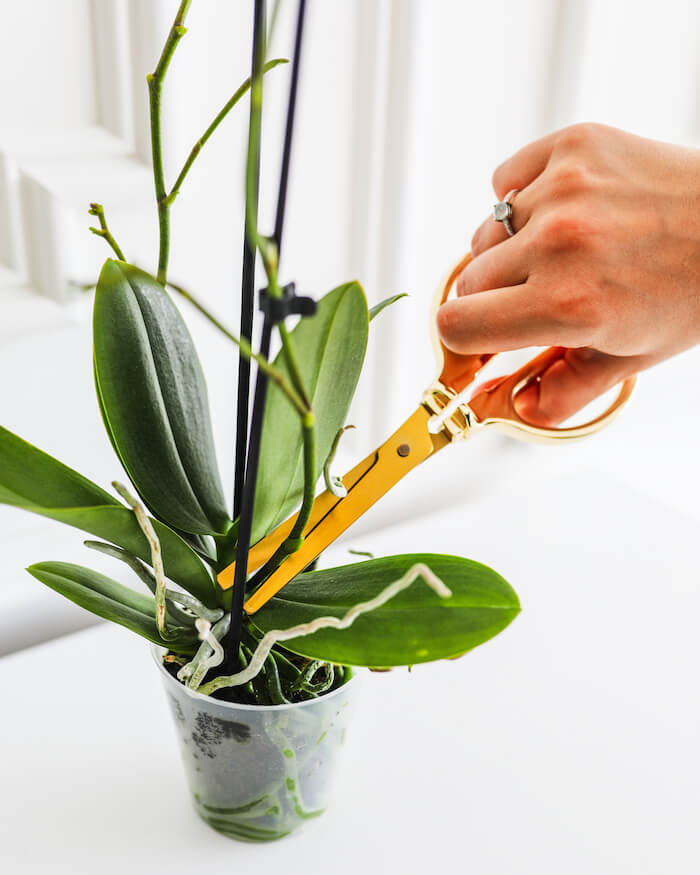
Your orchid arrived with vibrant blooms that made your guests ‘ooo’ and ‘ahhh.’ Slowly, its petals started dropping, finally leaving it with just the stalks. You know from reading our blog that it has probably entered its vegetative stage.
If you’re wondering how to prune an orchid’s flowering stems without killing it, or even why you should prune it at all, this post is all about pruning orchids!
Just in case you don’t already know, if you’ve kept your orchid moist and cool while exposing it to bright, diffused light, Phalaenopsis orchids can maintain their beautiful bloom display for up to four months.
Then, as the plant works through its energy stores, the petals will start to fall. This does not always mean the end of a blooming session, there is a chance to prune your orchid and find that it has enough energy to produce a few more blooms before it needs a rest again!
If you’ve ever had long hair, you probably know that trimming it every now and then to remove dry, brittle and split ends strengthens your hair.
Trimming unhealthy or dead structures on your orchid can help it conserve energy and redirect growth into more aesthetically pleasing directions. It can also shift the plant from one stage of growth to another, prevent bacterial or fungal infections, and more!
Orchid pruning is one of the things you can do to encourage reblooming, but this should only be done after all of the orchid blooms have fallen and the flowering stem starts to change colors.
Where you make the cut on your orchid’s stem is extremely important. Inspect the orchid stem. Every few inches along its length, you will notice a papery bract that encircles the stem. If you gently feel around the bracts, you will feel small bumps, called nodes. New stems, Keikis, and branches emerge from these nodes.
If all of the blooms have fallen and you successfully located the second bract from the base, grab your sterile scissors or pruners and follow these steps!
Carefully cut off the orchid stem a half inch to an inch above the second bract above the orchid’s base. In six weeks, if your orchid has enough energy in reserve, you should notice a new stalk growing from the node.
Place your plant near a north or east-facing window so that it will receive plenty of bright, indirect light. (Depending on where you live and the design of your home, a south-facing window may provide too much light for your orchid and cause sunburn!)
Make sure to set your thermostat so that your orchid will be exposed to cooler temperatures at night. (Or move it to a cooler spot each night.) Phalaenopsis Orchids require a 20-degree Fahrenheit temperature drop at night for new flowering stem or branch and bud instigation.
Continue to water your Just Add Ice Orchid with 3 ice cubes once a week.
Once or twice a month during the growing season (Spring and Summer), fertilize your orchid with a small amount of 20-20-20 fertilizer, diluted to one-quarter strength. Or find yourself an orchid-specific fertilizer and apply as recommended by the manufacturer!
In addition to watering, fertilizing and exposing your orchid to cooler temperatures to encourage reblooming, be sure to keep an eye on its health during the vegetative stage.
Check your orchid’s leaves and roots to ensure your orchid is still healthy. Mushy roots signal your plant is struggling. Yellowing leaves could be a sign of struggle as well, but not always. Many things can affect a plant other than overwatering or sunburn, such as orchid viruses.
As the weeks go on, you may see what you think is a new bud or orchid flower spike, but it may be an aerial root. Here’s how to tell the difference.
If you just can’t wait for those blooms to return, you can always adopt another orchid or do something altogether different and get an anthurium, the world’s longest-blooming plant!

Copyright Just Add Ice® Orchids 2023